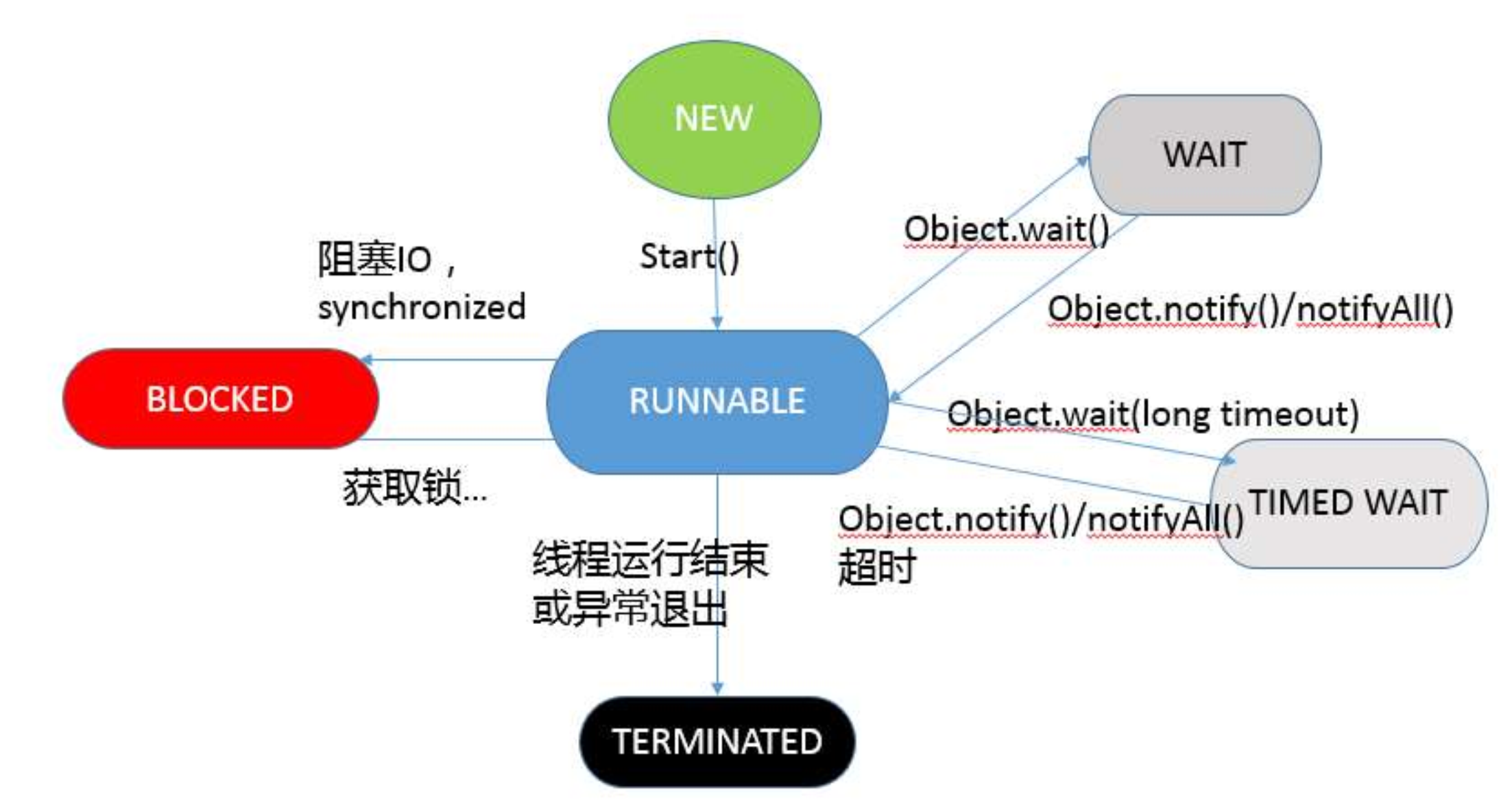线程状态
public enum State {
/**
* Thread state for a thread which has not yet started.
*/
NEW,
/**
* Thread state for a runnable thread. A thread in the runnable
* state is executing in the Java virtual machine but it may
* be waiting for other resources from the operating system
* such as processor.
*/
RUNNABLE,
/** 等待获取锁 synchronized关键字
* Thread state for a thread blocked waiting for a monitor lock.
* A thread in the blocked state is waiting for a monitor lock
* to enter a synchronized block/method or
* reenter a synchronized block/method after calling
* {@link Object#wait() Object.wait}.
*/
BLOCKED,
/** 等待被其他线程notify
* Thread state for a waiting thread.
* A thread is in the waiting state due to calling one of the
* following methods:
* <ul>
* <li>{@link Object#wait() Object.wait} with no timeout</li>
* <li>{@link #join() Thread.join} with no timeout</li>
* <li>{@link LockSupport#park() LockSupport.park}</li>
* </ul>
*
* <p>A thread in the waiting state is waiting for another thread to
* perform a particular action.
*
* For example, a thread that has called <tt>Object.wait()</tt>
* on an object is waiting for another thread to call
* <tt>Object.notify()</tt> or <tt>Object.notifyAll()</tt> on
* that object. A thread that has called <tt>Thread.join()</tt>
* is waiting for a specified thread to terminate.
*/
WAITING,
/**
* Thread state for a waiting thread with a specified waiting time.
* A thread is in the timed waiting state due to calling one of
* the following methods with a specified positive waiting time:
* <ul>
* <li>{@link #sleep Thread.sleep}</li>
* <li>{@link Object#wait(long) Object.wait} with timeout</li>
* <li>{@link #join(long) Thread.join} with timeout</li>
* <li>{@link LockSupport#parkNanos LockSupport.parkNanos}</li>
* <li>{@link LockSupport#parkUntil LockSupport.parkUntil}</li>
* </ul>
*/
TIMED_WAITING,
/**
* Thread state for a terminated thread.
* The thread has completed execution.
*/
TERMINATED;
}
几个方法
1.sleep:Thread类的方法,必须带一个时间参数。会让当前线程休眠进入阻塞状态并释放CPU,提供其他线程运行的机会且不考虑优先级,但如果有同步锁则sleep不会释放锁即其他线程无法获得同步锁
2.yield:Thread类的方法,类似sleep但无法指定时间并且只会提供相同或更高优先级的线程运行的机会,不推荐使用
3.wait:Object类的方法,必须放在循环体和同步代码块中,执行该方法的线程会释放锁,进入线程等待池中等待被再次唤醒(notify随机唤醒,notifyAll全部唤醒,线程结束自动唤醒)即放入锁池中竞争同步锁
4.join:一种特殊的wait,当前运行线程调用另一个线程的join方法,当前线程进入阻塞状态直到另一个线程运行结束
利用interrupt()改变线程状态为中断(不用interrupt不能马上中断sleep wait等)
线程里sleep wait join会检测线程是否中断,中断则跑抛出InterruptException异常,线程finally里做终止最后的操作
wait/notify
调用wait进入waiting;被其他线程notify同时线程还没出synchronize代码块时则进入BLOCKED状态 wait和notify
1)将notify放在wait方法前面,那么线程t1就无法唤醒
2)wait和notify方法必须要在同步块或者方法里面,且成对出现使用
两个线程,一个有奇数一个有偶数,按顺序打印1到100;使用wait/notify
Condition.await()/signal()
1) await()方法一定要在signal()方法之前 2) Condition中的线程等待和唤醒方法之前,需要先获取锁
LockSupport.park/unpark
优点:
1.更简单,不需要获取锁,能直接阻塞线程。
2.更直观,以thread为操作对象更符合阻塞线程的直观定义;
3.更精确,可以准确地唤醒某一个线程(notify随机唤醒一个线程,notifyAll唤醒所有等待的线程);
4.更灵活 ,unpark方法可以在park方法前调用。
缺点:
1)因为标志位1,所以只能唤醒一次线程。连续park() unpark()没有效果。
LockSupport的用法及原理
public class SimpleThreads {
// Display a message, preceded by
// the name of the current thread
static void threadMessage(String message) {
String threadName =
Thread.currentThread().getName();
System.out.format("%s: %s%n",
threadName,
message);
}
private static class MessageLoop
implements Runnable {
public void run() {
String importantInfo[] = {
"Mares eat oats",
"Does eat oats",
"Little lambs eat ivy",
"A kid will eat ivy too"
};
try {
for (int i = 0;
i < importantInfo.length;
i++) {
// Pause for 4 seconds
Thread.sleep(4000);
// Print a message
threadMessage(importantInfo[i]);
}
} catch (InterruptedException e) {
threadMessage("I wasn't done!");
}
}
}
public static void main(String args[])
throws InterruptedException {
// Delay, in milliseconds before
// we interrupt MessageLoop
// thread (default one hour).
long patience = 1000 * 60 * 60;
// If command line argument
// present, gives patience
// in seconds.
if (args.length > 0) {
try {
patience = Long.parseLong(args[0]) * 1000;
} catch (NumberFormatException e) {
System.err.println("Argument must be an integer.");
System.exit(1);
}
}
threadMessage("Starting MessageLoop thread");
long startTime = System.currentTimeMillis();
Thread t = new Thread(new MessageLoop());
t.start();
threadMessage("Waiting for MessageLoop thread to finish");
// loop until MessageLoop
// thread exits
while (t.isAlive()) {
threadMessage("Still waiting...");
// Wait maximum of 1 second
// for MessageLoop thread
// to finish.
t.join(1000);
// 如果时间过长,则中断t线程
if (((System.currentTimeMillis() - startTime) > patience)
&& t.isAlive()) {
threadMessage("Tired of waiting!");
t.interrupt();
// Shouldn't be long now
// -- wait indefinitely
t.join();
}
}
threadMessage("Finally!");
}
}

